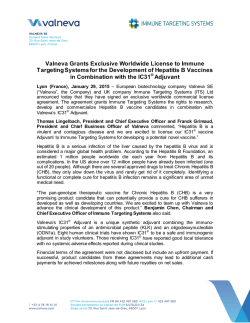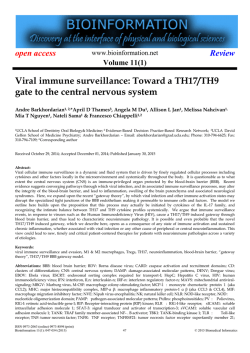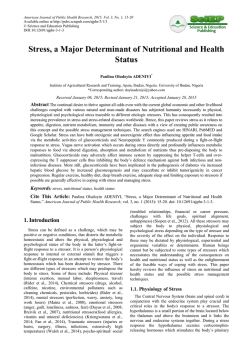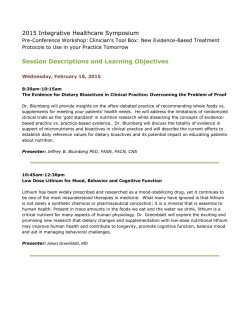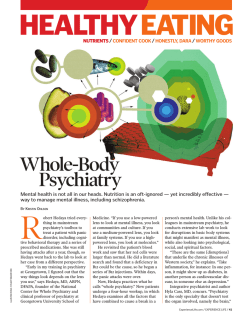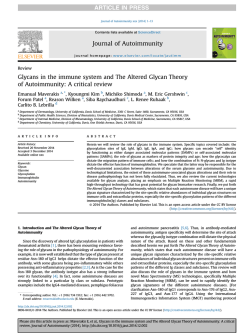
PDF (Chapter 34:Psychoneuroimmunology
Pridmore S. Download of Psychiatry, Chapter 34. Last modified: January, 2015. http://eprints.utas.edu.au/287/ 1 CHAPTER 34 PSYCHONEUROIMMUNOLOGY (NEUROENDOCRINEIMMUNOLOGY) “The nervous system and immune system speak a common biochemical language and communicate via a complete bidirectional circuit involving shared ligands such as neurotransmitters, hormones and cytokines” (Blalock, 2005). Psychological stressors Central Nervous system Autonomic Nervous system Endocrine system Physical stressors (Pathogens/toxins) Immune system Adapted from Wilder R. Annu Rev Immunol 1995; 13:307-38 The term “Psychoneuroimmunology” (PNI) was first used in the 1970s. Other long terms have also been used to describe the interactions of various fields: psychology and the nervous, endocrine and immune systems. A brief chapter is justified, as 1) these 4 fields have evolved separately and their interactions have not been widely described, and 2) the impact of immune system on these other system is not yet well covered in psychiatric textbooks. “Stress” is the central issue and is defined as a general body response to initially threatening external or internal demands. Longer definitions mention disturbance of homeostasis, and much of this chapter deals with mechanism which work to restore homeostasis. Pridmore S. Download of Psychiatry, Chapter 34. Last modified: January, 2015. http://eprints.utas.edu.au/287/ 2 “Cytokines” are a category of “signaling molecules” which enable cellular communication. The distinction between cytokines and hormones is becoming less clear/important. Cytokines are produced by immune cells, particularly, monocytes and macrophages, (but also by brain neurons and glial elements; Breder et al, 1988). “Circumventricular organs” (CVOs) are structures bordering the 3rd and 4th ventricles, regions of the brain in which the capillary bed does not form a blood brain barrier (BBB), but instead the vessels are leaky. They allow penetration of the barrier by hormones, neurotransmitters and cytokines. “Sickness behavior” refers to the symptoms associated with inflammation (low mood, reduced appetite, increased fatigue and social withdrawal; Irwin and Cole, 2011). This follows penetration of the blood brain barrier and access to the hypothalamus by cytokines released from activated immune cells (and toxic products from bacterium cell walls). Interestingly, many of these symptoms are shared with depressive disorder. Studies report 16-45% of patients treated with interferon (IFN)-alpha develop depressive symptoms during the course of therapy (Hauser et al, 2002). This is not to suggest that all depressive disorder is an immune response (although the case has been made that a sub-set of depression may be of immunological origin; Howren et al, 2009), but it alerts us to the difficulties which may be encountered when making psychiatric assessments of physically unwell patients. The neuroendocrine system Hans Seyle (1937) was the pioneer of “biological stress”. He demonstrated that a noxious stimulus (called a stressor) induces the release of adrenal cortical steroids. From early stress response investigations, neural and endocrine system interactions were noted, leading to the concept of the “neuroendocrine system”. When stress impacts on the brain, there are two outflow pathways to the periphery. One is the hypothalamic-pituitary-adrenal (HPA) axis – traditionally termed part of the endocrine system – but here termed neuroendocrine because of the input from hypothalamic nuclei (particularly the paraventricular nucleus). Neuroendocrine cells receive neuronal input (neurotransmitter stimuli) and release hormones. Ultimately, glucocorticoids from the adrenal cortex. The other involves the sympathetic nervous system (commencing with corticotropin releasing hormone (CRH) stimulation of the locus ceruleus (LC) in the brain stem). It is conceptualized as having three parts. First, neural communication leading to release of epinephrine and norepinephrine from the adrenal medulla (Nicolaides et al, 2015). Second, neural communication with cells and tissues with an immune function (liver, spleen, bone marrow, thymus, lymph nodes, skin and gastrointestinal system). And third, neural communication which directly prepares the body for action (dilating blood vessels to the muscles, constricting blood vessels to the skin, etc). Pridmore S. Download of Psychiatry, Chapter 34. Last modified: January, 2015. http://eprints.utas.edu.au/287/ 3 The immune system The immune system responds to physical assault (in the form of pathogenic microorganisms and tumor cells). [However, recently it has been demonstrated that social stressors can also trigger immune system activity (Lacy et al, 2013).] The immune system is complicated, with components including an intact skin through to specialized cells (Killer T cells) and specific molecules called antigens. Of particular interest in the current chapter (which attempts to integrate the immune and neuroendocrine systems) are chemicals (neurotransmitters, hormones and cytokines) which are released by the cells of one system and impact on the cells of the other. (The notion that there is more than one system, is of course, arbitrary, and reflects the history of scientific discovery.) Stimulation from other brain centers Inhibition from other brain centers CRH (increasing) Brainstem locus ceruleus Hypothalamus CRH Pituitary NE (increasing) (+) (+) Cortisol (-) (+) IL-1, IL-6 ACTH (+) Sympathetic Nervous system Adrenal cortex NE Cortisol (reducing) (reducing) Immune system Adapted from Wilder R. Annu Rev Immunol 1995; 13:307-38 Pridmore S. Download of Psychiatry, Chapter 34. Last modified: January, 2015. http://eprints.utas.edu.au/287/ 4 Modulation A comprehensive account of the bi-directional modulation of these systems is beyond the expertise of the current author. Instead, some examples are offered, which support the notion that these systems are highly integrated. Future research can be expected to provide additional details and open new therapeutic avenues. The immune modulating the neuroendocrine system: examples 1. Cytokines, interleukin-1 (IL-1), IL-2, IL-6, tumor necrosis factor-alpha (TNFalpha) and interferon-gamma (IFN-gamma) pass through the circumventricular organs and impact on the hypothalamus, leading to fever and sickness behavior. 2. Cytokines impacting on the HPA lead to cortisol release from the adrenal cortex (Chowers et al, 1996; Dunn et al, 1999). 3. Immune cells synthesize IFN which passes the blood brain barrier, impacts on brain and may cause “depression” (Hauser et al, 2002). 4. Elevated levels of C-reactive protein and IL-6 in children are associated with behavior problems (Slopen et al, 2013). 5. Lymphocytes synthesize hormones including ACTH, prolactin and growth hormone (Wilder, 1995). 6. Peripheral cytokines stimulate afferent pathways such as the vagus nerve which leads to the release of cytokine and stimulation of brain cells (McCusker and Kelley, 2013). 7. Cytokines reduce the efficiency of glucocorticoid receptors (resistance) which reduce the negative feedback (which may have a role in depression) (Pace and Miller, 2009). 8. Acetylcholine and adrenaline neurotransmitters, and hormones [recently, melatonin] are endogenously produced in the immune system (Blalock, 2005). For (simplified) details, see the following list: Source Hormone/neurotransmitters Lymphocytes Acetylcholine, melatonin T Lymphocytes ACTH, endorphins B Lymphocytes ACTH, endorphins Macrophages ACTH, endorphins Splenocytes Adrenalin, CRH, Megakaryocytes Neuropeptide Y The neuroendocrine modulating the immune system: examples 1. Sympathetic/noradrenergic nerve fibers innervate important organs and systems related to the immune system, including the liver, spleen, thymus, bone marrow, lymph nodes, skin, and digestive tract and respiratory apparatus (Montoro et al, 2009; Irwin and Cole, 2011). 2. Adrenergic receptors are located on lymphocytes (Hadden et al, 1970). Pridmore S. Download of Psychiatry, Chapter 34. Last modified: January, 2015. http://eprints.utas.edu.au/287/ 5 3. Catecholamines and corticoids suppress the production of IL-12 by immune cells (Elenkov and Chrousos, 1999). 4. Increased cortisol suppresses immune function (McEwen et al, 1997). 5. Cortical steroids directly affect immune cells, increasing the production of IL-4, 10 and 13 (DeKruyff et al, 1998). 6. Neuropeptide, neurotransmitter and neuroendocrine hormone receptors are located on immune cells (Blalock, 2005). 7. Neurotransmitters (acetylcholine, noradrenaline, serotonin, histamine, glutamic acid, GABA), neuropeptides (ACTH, Prolactin, Vasopressin, Bradykinin, Somatostatin, VIP, SP, Neuropeptide Y, encephalin, endorphin), neurological growth factors (NGF) and hormones (adrenalin and corticoids) modulate immune function (Montoro et al, 2009). 8. Neurons synthesize IL-1 and other cytokines (Breder, 1988). 9. Parental separation results in higher levels of C-reactive protein in the adult (Lacy et al, 2013). 10. Exogenous administration of CRH and ACTH produce a substantial increase in IL-6 in the adrenal glands (Hueston and Deak, 2014). 11. Marital distress has long-term immune consequences (Jaremka et al, 2013). Clinical aspects The Holy Grail The Holy Grail of PNI is around the question of whether psychological factors (presumably modifiable) can be employed to moderate the immune system and influence the onset and outcome of physical diseases. Diseases of particular interest include infections (such as hepatitis and AIDS), autoimmune diseases (such as rheumatoid arthritis and multiple sclerosis) and cancer. Possible psychological interventions include the talking and relaxation/hypnosis therapies and in the broader context, social engineering to reduce loneliness, isolation and poverty. Earlier finding were encouraging: 1. Healthy students under examination stress manifest a decrease in indicators of cellular immune response (Glaser et al, 1986). 2. Stressful life events can play a part in the onset and exacerbation of auto-immune diseases (Homo-Delarche et al, 1991; Nakata, 2012). 3. Cognitive-behavioral interventions have been associated with improved physical symptoms of some auto-immune disorders (Radojevic, 1992). 4. Some studies involving education and psychological treatment have demonstrated increased cancer survival (Spiegel et al, 1989; Fawzy et al, 1993). Pridmore S. Download of Psychiatry, Chapter 34. Last modified: January, 2015. http://eprints.utas.edu.au/287/ 6 More recent work continues to promise benefits from psychological therapy for physical disease (Armaiz-Pena, 2009), but progress has been slow. An important review (Miller and Cohen, 2001) somewhat unexpectedly, found that the immune system shows little response to psychological intervention, and another (Montoro et al, 2009) did not find chronic stress to be an intrinsic cause of allergy. Nevertheless, beneficial effects of social support and connectedness on the immune system continues to be anticipated (Audet et al, 2014). While psychological therapy improves the outcomes in certain physical disorders, it is not yet established that this is attributable to alterations in the immune system (that is, the benefits of reduced distress, relaxation and increased confidence may simply enable individuals to deal better with their disorder). Factors associated with the nervous, endocrine and immune systems have been proposed as the explanation of the poor health status associated with poverty and low social status (Littell, 2008; Kemeny 2009). While some such elements may be involved, much work is needed before definitive conclusions can be made on this topic. Non-Holy Grail stuff 1. Should a sub-section of depression prove to be due to immune dysregulation (Eisenberger et al, 2010; Jarcho et al, 2013), a new avenue for treatment (for this sub-section, at least) will be opened. There is already a suggestion that the augmentation of antidepressants with anti-inflammatory agents (aspirin, celecoxib) can be beneficial (Blume et al, 2011). 2. Complicated grief – similar in many ways to depression – appears to be associated with dysregulation of the immune system (O’Connor, 2012). 3. Anxiety has also been associated with dysregulation of the immune system (Salim et al, 2012). 4. Unsurprisingly, PTSD has disturbed psychoneuroimmunological features (Pace & Heim, 2011). 5. Some evidence suggests cognitive decline and dementia may also be associated with “over-expressed cytokines” (McAfoose and Baume, 2009). 6. A role for the immune system in the etiology of schizophrenia (Tomasik et al, 2014) and bipolar disorder (Barbosa et al, 2014) has been discussed. 7. Epigenetics is a most exciting new field which has given us a biological mechanism by which “psychosocial world” can modify our neurologicalendocrinological-immunological inner world (Mathews & Janusek, 2011). Pridmore S. Download of Psychiatry, Chapter 34. Last modified: January, 2015. http://eprints.utas.edu.au/287/ 7 Conclusion “There is increasing evidence of a strong interconnectivity between genetic disposition, epigenetic processes, stress-related hormonal systems and immune parameters in all forms of (mal)-adjustment to adverse living conditions” (Ehlert, 2013). Close integration and bi-directional communication between the neuroendocrine and immune systems has been demonstrated. Work reviewed in this chapter provides possible mechanisms by which such disease prevention and improved outcomes might be achieved. Evidence indicates that psychological therapy may improve the outcome of physical disorders. However, it is not yet proven that such improvements are the result of alterations in immune function (although at least in some cases, this is probable). Depression, schizophrenia, bipolar disorder, anxiety, PTSD, dementia and other disorders may have unexpected roots, and new therapies may be quite close. And, epigenetics, at last, provides a mechanism to bridge the psychological-physical divide. References Armaiz-Pena G, Lutgendorf S, Cole S, Sood A. Neuroendocrine modulation of cancer progression. Brain Behav Immun 2009; 23:10-15. Audet M, McQuaid R, Merali Z, Anisman H. Cytokine variations and mood disorders influence of social stressors and social support. Front Neurosci 2014; 8: 416. Barbosa I, Bauet M, Machado-Vieira R, Teixeira A. Cytokines in bipolar disorder: paving the way for neuroprogression. Neural Plast 2014. doi: 10.1155/2014/360481. Blalock J. The immune system as the sixth sense. Journal of Internal Medicine 2005; 257:126-138. Blume J, Douglas S, Evans D. Immune suppression and immune activation in depression. Brain, Behavior, and Immunity 2011; 25:221-229. Breder C, Dinarello, C, Saper C. Interleukin-1 immunoreactive innervation of the human hypothalamus. Science 1988; 240, 4850, 321-324. Chowers I, Hammel H, Eisenman J, et al. A comparison of the effects of environmental and preoptic heating and pyrogen on plasma cortisol levels. American Journal of Physiology 1996; 210:606-610. Cohen S, Herbert T. Health psychology: psychological factors and physical disease from the perspective of human psychoneuroimmunology. Annual Reviews Psychology 1996; 47:113-142. DeKruyff R, Fang Y, Umetsu D. Corticosteriods enhance the capacity of macrophages to induce Th2 cytokine synthesis in CD4+ lymphocytes by inhibiting IL-12 production. Journal of Immunology 1998; 160:2231-2237. Dunn A, Wang J, Ando T. Effects of cytokines on cerebral neurotransmission. Comparison with the effects of stress. Adv Exp Med Biol 1999; 461:117-127. Pridmore S. Download of Psychiatry, Chapter 34. Last modified: January, 2015. http://eprints.utas.edu.au/287/ 8 Ehlert U. Enduring psychobiological effects of childhood adversity. Psychoneuoendocrinology 2013; 38: 1850-1857. Elenkov I, Chrousos G. Stress hormones, Th1/Th2 patterns, pro/anti-inflammatory cytokines and susceptibility to disease. Trends in Endochrinology and Metabolism 1999; 10:359-368. Fawzy F, Fawzy N Hyun C, et al. Malignant melanoma: effects of an early structured psychiatric intervention, coping, and affective state on recurrence and survival six years later. Archives of General Psychiatry 1993; 50:681-689. Glaser R, Rice J, Speicher C, Stout J, Kiecolt-Glaser J. Stress depresses interferon production by leukocytes concomitant with a decrease in natural killer cell activity. Behavioral Neuroscience 1986; 100:675-678. Hadden J, Hadden E, Middleton E. Lymphocyte blast transformation. Demonstration of adrenergic receptors in human peripheral lymphocytes. Cell Immunol 1979; 1:583-595. Hauser P, Khosla J, Aurora H, et al. A prospective study of the incidence and open-label treatment of inferno-induced major depressive disorder in patients with hepatitis C. Molecular Psychiatry 2002; 7:942-947. Hueston C, Deak T. The inflamed axis: the interaction between stress, hormones, and the expression of inflammatory-related genes with key structures comprising the hypothalamic-pituitary-adrenal axis. Physiol Behav 2014; 124: 77-91. Homo-Delarche F, Fitzpatrick F, Christeff N, Nunez E, Bach J, Dardenne M. Sex steroids, glucocorticoids, stress and autoimmunity. Journal of Steroid Biochemistry and Molecular Biology 1991; 40:619-637. Howren M, Lamkin D, Suls J. Associations of depression with C-reactive protein, IL-1, and IL-6: a meta-analysis. Psychosomatic Medicine 2009; 71:171-186. Ir win M, Cole S. Reciprocal regulation of the neural and innate immune systems. Nature Rev Immunol 2011; 11:625-632. Jarcho M, Slaqvich G, Tylova-Stein H, et al. Dysregulated diurnal cortisol pattern is associated with glucocorticoid resistance in woment with major depressive disorder. Biolog Psychol 2013; 93:150-158. Jaremka L, Glasser R, Malarkey W et al. Marital distress prospectively predicts poorer cellular immune function. Psychoneuroendocriology 2013; 38: 2713-2719. Kemeny M. Psychological responses to social threat. Brain Behav Immun 2009; 23:1-9. Social status impacts on the endocrine and immune systems. Lacey R, Kumari M, McMunn A. Parental separation in childhood and adult inflammation. Psychoneuroendocrinology 2013; 38: 2476-2484. Littell J. The mind-body connection: not just a theory anymore. Social Work Health Care 2008; 46:17-37. McCusker R, Lelley K. Immune-neural connections: how the immune system’s response to infectious agents influences behaviour. J Exp Biol 2013; 216: 84-98. Mathews H, Janusek L. Epigenetics and Psychoneuroimmunology: mechanisms and models. Brain, Behavior, and Immunity 2011; 25:25-39. McAfoose J, Baune B. Evidence for a cytokine model of cognitive function. Neuroscience and Biobehavioral Reviews 2009; 33:355-366. McEwen B, Biron C, Brunson K et al. The role of andrenocorticoids as modulations of immune function in health and disease. Brain Res Brain Res Rev 1997; 23(1-2):79-133. Pridmore S. Download of Psychiatry, Chapter 34. Last modified: January, 2015. http://eprints.utas.edu.au/287/ 9 Miller G, Cohen S. Psychological interventions and the immune system: a meta-analytic review and critique. Health Psychology 2001; 20:47-63. Montoro J, Mullol J, Jauregui I et al. Stress and allergy. J Invetig Allergol Clin Immunol 2009; 19, Supple 1: 40-47. Nakata A. Psychosocial job stress and immunity: a systematic review. Methods Mol boil 2012; 934:39-75. Nicolaides N, Kyratzi E, Lamprokostopoulou A, Chrousos G, Charmandari E. Stress, the stress system and the role of glucocorticoids. Neuroimmunomodulation 2015; 22: 6-19. O’Connor M. Immunological and neuroimaging biomarkers of complicated grief. Dialogues in Clinical Neuroscience 2012; 14:141-148. Pace T, Heim C. A short review on the Psychoneuroimmunology of posttraumatic stress disorder: from risk factors to medical comorbidities. Brain, Behavior, and Immunity 2011; 25:6-13. Pace T, Miller A. Cytokines and glucocorticoid receptor signalling. Ann N Y Acad Sci 2009; 1179: 86-102. Radojevic V, Nicassio P, Weisman M. Behavioral intervention with and without family support for rheumatoid arthritis. Behavior Therapy 1992; 23:13-30. Salim S, Chugh G, Asghar M. Inflammation in anxiety. Adv Protein Chem Struct Biol 2012; 88:1-25. Selye H. The significance of the adrenals for adaptation. Science 1937; 85:247-248. Wilder R. Neuroendocrine-immune system interactions and auto-immunity. Annual Review Immunology 1995; 13:307-338. Slopen N, Nubzansky L, Koenen K. Internalizing and externalizing behaviors predict elevated inflammatory markers in childhood. Psychoneuroendocrinology 2013; 38: 28542862. Spiegel D, Bloom J, Kraemer H, Gotthel E. Effect of psychosocial treatment on survival of patients with metastatic breast cancer. Lancet 1989: ii:901. Steinmann L. Elaborate interactions between the immune and nervous systems. Nature Immunology. 2004; 5:575-581. Tomasik J, Rahmoune H, Guest P, Bahn S. Neuroimmune biomarkers in schizophrenia. Schiz Res 2014. doi: 10.1016/j.schres.2014.07.025. Wilder R. Neuroendocrine-immune system interactions and auto-immunity. Annual Review Immunology 1995; 13:307-338.
© Copyright 2025
